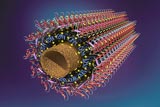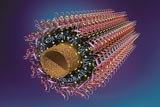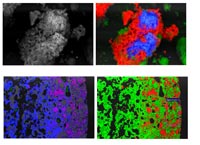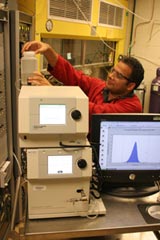
NanoRisk: What Can You Do About It?
- By Justin Teeguarden, Amit Gupta, Mark Clark, Sr.
- May 08, 2008
If you work in the electronic, biomedical, pharmaceutical, cosmetic, energy, catalytic, and materials industries and your employer uses nanoparticles or materials that contain nanoparticles, you may be at risk for exposure.
The American Industrial Hygiene Association estimates that 4 million people in the United States are expected to be exposed to nanometer-diameter particles on a regular basis as these industries grow. Because of their size, nanoparticles (between 1 and 100 nanometers) can penetrate deep into the body, even crossing the blood-brain barrier. They often exhibit different characteristics as the same materials at larger scales.. In fact, nanoparticles tend to be more chemically reactive, potentially making normally harmless materials toxic in tiny amounts (Bass 2008; Figure 1).
Figure 1. Carbon nanotubes, cylindrical molecules less than a
billionth of the width of a human hair, have extraordinary strength,
unique electrical properties, and the ability to conduct heat
efficiently. But nanomaterials also may pose unique occupational
hazards.
Scientists do not know all of the problems related to exposure, but the National Institute of Occupational Safety and Health (NIOSH) has determined the following:
• Nanomaterials have the greatest potential to enter the body if they are in the form of nanoparticles, agglomerates of nanoparticles, and particles from nanostructured materials that become airborne or come into contact with the skin.
• Nanoparticles can be inhaled and deposited in the respiratory tract. Airborne nanomaterials can enter the bloodstream and move to other organs.
• Insoluble ultrafine particles, smaller than 100 nanometers, are more potent than large particles of similar composition in causing pulmonary inflammation and lung tumors in laboratory animals. However, changes in the chemical composition, structure of the molecules, or surfaces properties of certain nanomaterials can influence their potential toxicity.
Given the limited information available and evolving guidance, companies and universities have relied on conventional chemical management practices to deal with nanomaterial safety. As nanomaterial issues have broadened to include corporate liability and reputation, more organizations are looking into worker exposure and how to better reduce it.
Workers are exposed when nanoparticles are released during product manufacturing or research. The particles can move into industrial waste streams, treatment or disposal areas, and the environment. Certain workplace tasks increase the risk of exposure, such as pouring or mixing liquids; handling powders, machining, sanding, and drilling; maintaining equipment; and cleaning spills or dust collection systems (NIOSH 2006).
Determining Exposure and Dose
Once a facility identifies potential exposure pathways, health experts must assess workplace exposure. Because of their unique characteristics and behaviors, nanomaterials require testing approaches that are specific to them.
Nanomaterials toxicity testing requires characterizing the material’s properties and accurately measuring doses to determine safe exposure levels. Nanomaterials, however, are difficult to observe, analyze, handle, and keep in their original form. Entirely different technologies, such as real-time measurements of particle properties, are required to determine how much of a material exists in a tissue or exposure system. Toxicologists also must identify the characteristics of the material—its particle size, form, shape, and surface chemistry—because one or more of these properties may affect toxicity.
The starting point is to design a plan for sampling and characterizing particles and to select tools and methods appropriate for the workplace setting. Conditions such as spatial and temporal sampling requirements, background particle levels, and the type of materials present in the air should be considered.
Real-time aerosol monitoring combined with post-sampling physical and chemical measurements are good approaches to measuring dose and identifying nanomaterial characteristics. Specialized instruments and methods are available to monitor and characterize particle size and other characteristics (Teeguarden et al., 2008; Figures 2 and 3).
 Figure 2. Understanding nanoparticle
characteristics such as chemistry, form, and structure (as shown by
different colors in the figure) is an important step in assessing
health risk.
Figure 2. Understanding nanoparticle
characteristics such as chemistry, form, and structure (as shown by
different colors in the figure) is an important step in assessing
health risk.
Workplace Health Risk Assessments
After measuring exposure and dose comes health risk assessment. Since 2004, NIOSH's Nanotechnology Research Center has conducted toxicology research on the properties and characteristics of nanoparticles to predict potential health effects in workers (NIOSH 2006 and NTRC 2007).
NIOSH recommends that every workplace dealing with nanoparticles should consider an occupational health surveillance program and take precautionary measures such as the following:
• Control airborne exposure to nanoaerosols with engineering techniques similar to those used for aerosols in general, like using source enclosure (isolating the generation source from the worker) and local exhaust ventilation systems. A well-designed exhaust ventilation system with a high-efficiency particulate air (HEPA) filter should effectively remove nanoparticles.
• Clean work areas using HEPA vacuum pickup and wet wiping methods, prevent the consumption of food or beverages in workplaces where nanomaterials are handled, and provide facilities for handwashing, showering, and changing clothes.
• Wear respirators when engineering and administrative controls do not adequately prevent exposures. Respirator filtration media capture particulates as small as 2.5 nanometers in diameter. This suggests that NIOSH-certified respirators will be useful for protecting workers from nanoparticle inhalation when properly selected and fit-tested as part of a complete respiratory protection program.

Figure 3. With specialized instruments such as this scanning
mobility particle size analyzer at Battelle Toxicology Northwest,
researchers can measure particle size distribution and concentration
during exposure.
No guidelines are available on protective clothing to prevent skin exposure to nanoaerosols. However, some clothing standards incorporate testing with nanoscale particles.
NIOSH’s final “Approaches to Safe Nanotechnology” guidance document is expected to come out this year. In the mean time, companies and research labs that generate nanomaterials are wise to take the precautionary measures described here. This includes working with experienced and reputable nanotoxicology laboratories to assess workplace-specific exposures and risks.
References
Bass, C. February 2008. “As Nanotech’s Promise Grows, Will Puny Particles Present Big Health Problems?” Scientific American. http://www.sciam.com/article.cfm?id=will-nano-particles-present-big-health-problems&page=1.
International Council on Nanotechnology. Nov. 13, 2006. A Review of Current Practices in the Nanotechnology Industry. Phase Two Report: Survey of Current Practices In the Nanotechnology Workplace. http://cohesion.rice.edu/CentersAndInst/ICON/emplibrary/ICONNanotechSurveyFullReduced.pdf
National Institute for Occupational Safety and Health (NIOSH). 2006. “Approaches to Safe Nanotechnology: An Information Exchange with NIOSH. Draft for Public Comment." U.S. Department of Health and Human Services, Centers for Disease Control and Prevention, NIOSH. http://www.cdc.gov/niosh/topics/nanotech/safenano/summary.html
NIOSH Nanotechnology Research Center (NTRC). June 2007. “Progress Toward Safe Nanotechnology in the Workplace.” U.S. Department of Health and Human Services, Centers for Disease Control and Prevention, NIOSH. DHHS (NIOSH) Publication No. 2007–123, Cincinnati, Ohio.
Teeguarden, J., Gupta, A., Escobar, P., Jackson, M. March 2008. "Toxicology Steps Up to Nanotechnology Safety."R&D Magazine. http://www.rdmag.com/pdf/RD82LabPNNLWeb.pdf
The authors thank Vladimir Murashov Ph.D., of the National Institute for Occupational Safety and Health for serving as a resource for this article.
About the Authors
By Justin Teeguarden, senior scientist, Pacific Northwest National Laboratory, Richland, Wash.
Amit Gupta, research scientist, Battelle Toxicology Northwest, Richland, Wash.
Mark Clark, Sr., research scientist, Battelle Toxicology Northwest.
Battelle is an R&D organization with expertise in aerosol physics and chemistry and the design and implementation of particulate sampling, capture, and characterization systems. Battelle Toxicology Northwest has expertise and equipment for physical and chemical characterization of nanomaterials. Battelle operates Pacific Northwest National Laboratory for the U.S. Department of Energy.